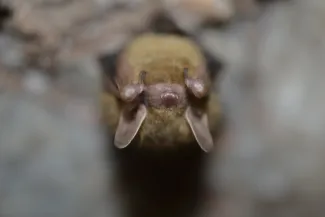Bats and the fungus that has led to widespread bat declines were the focus of a recently completed study by the Sam Noble Museum of Natural History. From 2018 to 2024, researchers conducted bat surveys to learn about Oklahoma’s bat community and test for the presence of the fungus that causes white-nose syndrome. The tricolored bat, a species of greatest conservation need, was of particular interest.

📷 Tricolored bat with no signs of fungal growth
White-nose syndrome is caused by a fungus, Pseudogymnoascus destructans, that grows on hibernating bats’ muzzles and wings. It is thought this causes changes in the bats, waking them when their food resources – namely insects – are minimal. Because these wakened bats use valuable stored energy and are likely unable to refuel by eating, they may not survive the winter. First documented in New York bats in 2006, the fungus and disease have since spread across the United States and Canada. The fungus was first detected in Oklahoma in 2016, and the disease was confirmed in 2017.
To learn more about the presence of the fungus that causes white-nose syndrome in Oklahoma bats, the research team tested specimens from multiple historical collections, took samples from bats caught in summer trapping sessions, and analyzed swabs taken from bats in six Oklahoma caves.
Results: P. destructans Testing
- The research team first visited 14 natural history museums and swabbed tricolored bat specimens that had been captured in Oklahoma. The bulk of these specimens, about 60%, were collected in the 1950s and 60s. Each of the 308 historic specimens tested negative for P. destructans, indicating no historical prevalence of the fungus on tricolored bats in Oklahoma.
- Next, the team visited 35 sites in 10 central and western Oklahoma counties from June to September in 2019, 2021, and 2022 in an attempt to capture tricolored bats and sample for the fungus. While no tricolored bats were captured during the three survey years, 19 individual bats of four species were found in the nets and swabbed. Each of these sampled bats tested negative for the fungus. Two additional bats donated to the Sam Noble Museum of Natural History were also sampled and tested negative for the fungus.
- The research team was able to extend their fungal sampling to include swabs taken in six central and western Oklahoma caves during winter bat surveys from 2020-2023. Twenty-four (8.6%) of the 279 samples were positive for the fungus that causes white-nose syndrome. Of the 33 samples taken from tricolored bats, three were positive for the fungus.Samples analyzed as part of this study also confirmed the presence of the fungus in Arbuckle Mountain caves for the first time.
In addition to surveying the presence of P. destructans in Oklahoma’s tricolored bats, the research team used acoustic recorders to survey the bat communities at 30 central and western Oklahoma sites. The detectors record bat echolocation calls and automatically identify the calls to species from the resulting ultrasound. These identifications may be manually vetted by investigators to confirm the species detected.
Results: Acoustic Monitoring
- The first recorder was stationed at the Sam Noble Museum of Natural History in Norman as a baseline and detected eight species of bat across 56 continuous months of monitoring. As expected, bat calling activity was lowest during winter months – when the insects bats forage for are at minimum – and increased dramatically in March when many bats begin migrating or leaving their overwintering sites.
- A second recorder was rotated across 31 sites, including 12 areas managed by the Wildlife Department, approximately every five weeks. Thirteen species of bat were detected across the sites, including expected and somewhat unexpected species. Calls of the widespread eastern red bat were detected at the highest number of sites and were detected in every month of the year. Calls of the little brown myotis were only detected at two sites. This species has been documented in a wide area within the U.S. and Canada, but few specimen and observation records have been made in Oklahoma. This project’s acoustic detection of the little brown myotis in Marshall and Okfuskee counties may represent the extreme western edge of the migratory range of little brown bats in Oklahoma.
- The call recordings and associated weather information have all been archived with the North American Bat Monitoring Program and have been requested for use by other research teams multiple times.
This study was funded by the Oklahoma Department of Wildlife Conservation and U.S. Fish and Wildlife Service through State Wildlife Grant F18AF00629 with matching resources provided by the University of Oklahoma and Sam Noble Oklahoma Museum of Natural History.